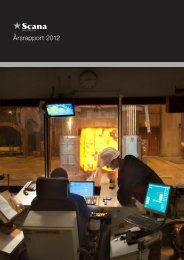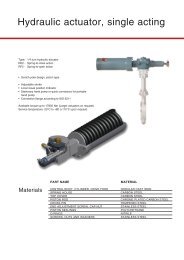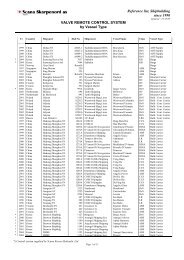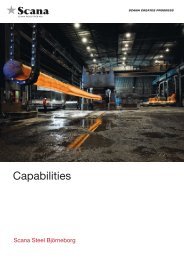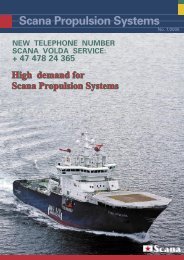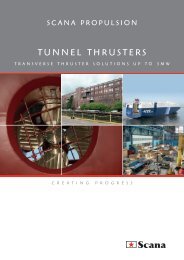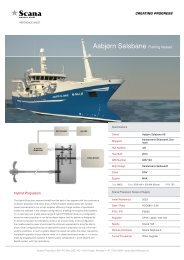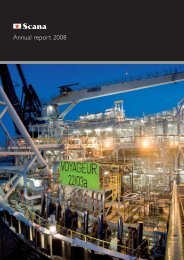Annual Report 2010 - Scana Industrier ASA
Annual Report 2010 - Scana Industrier ASA
Annual Report 2010 - Scana Industrier ASA
You also want an ePaper? Increase the reach of your titles
YUMPU automatically turns print PDFs into web optimized ePapers that Google loves.
75In <strong>2010</strong>, <strong>Scana</strong> was affected by cancellations mainly within the Steelarea. The Marine area has only had cancellations to a limited extent.<strong>Scana</strong> Volda established credit insurance with GIEK Kredittforsikringin 2009 in order to cover the exposure to credit risk. Within the Marinearea, the biggest deliveries are to financially robust shipyards in Chinaand Korea with a large degree of state ownership. Within the Oil & Gasarea, service and after sales services are carried out for internationalleading players. No major reduction is expected in the level of activityin this market segment, and the credit risk is considered to be limited.Increased activity is expected within new projects and expansions.Sensitivity analysisIn accordance with IFRS 7, a sensitivity analysis shall be carried out for all financial instruments that are held on the balance sheet date. In theillustration below, the sensitivity analysis shows material effects linked to financial instruments.<strong>Annual</strong> <strong>Report</strong> <strong>2010</strong> <strong>Scana</strong> <strong>Industrier</strong> <strong>ASA</strong>Currency riskThe financial instruments that have currency effects are currency contracts, syndicate loans, accounts receivable, creditors and bank deposits.The table shows the effects of changes in foreign currency against NOK. If foreign currency increases by 5% against the NOK, this has a negativeeffect on the result linked to net assets of NOK 34.7 million. Correspondingly, if NOK strengthens against foreign currency, the effect on the resultis positive.Change in NOK Effect on profit before tax Effect on total profit<strong>2010</strong> 5 % -34 749 0-5 % 34 749 02009 5 % -30 313 0-5 % 30 313 0Price risk on electricityThe table below shows the effects linked to changes in electricity prices based on the portfolio of electric derivatives that the group has on thebalance sheet date. An increase in electricity prices will mean a positive change in value on profit and equity.Change in electricity price Effect on profit before tax Effect on total profit<strong>2010</strong> 40 øre 849 8 901-40 øre -849 -8 9012009 40 øre 1 525 6 244-40 øre -1 525 -6 244Interest rate riskThe table below shows the effects linked to interest rate changes in the group on the balance sheet date. The table shows that increased interestrates have a negative effect on profit.Change in interest rate Effect on profit before tax Effect on total profit<strong>2010</strong> 1 % -2 133 5 747-1 % 2 133 -5 7472009 1 % -1 618 6 830-1 % 1 618 -6 830Note 23. Financial instrumentsHedging net investmentThe group is subject to currency exposure in the form of a net investment in its Swedish subsidiaries. The net investment is defined as <strong>Scana</strong>’sshare of the subsidiaries’ equity. In order to protect against major currency fluctuations, <strong>Scana</strong> has taken out a loan in SEK. In accordance withthe rules on hedge accounting of net investments, currency gains/losses on this loan are recorded against the total comprehensive income to thedegree the loan is offset by the net investment.Hedging currency riskSince a significant part of the group’s sales are carried out in foreign currencies, <strong>Scana</strong> is exposed to exchange rate fluctuations during the periodfrom the time the sales contract is entered into to final payment by the customer. There is also a risk linked to future payments in foreign currency.In order to secure the group’s net cash flow in the individual currencies, currency contracts are entered into that offset the estimated futureincoming/outgoing payments.Classification of currency gains/losses in the profit and loss accountThe group classifies currency gain/loss as financial items. Most subsidiaries have chosen to hedge the net currency exposure based on thebalance positions and sales and purchase orders for each individual currency. Hedge accounting in accordance with IAS 39 is not applied tocurrency contracts.



